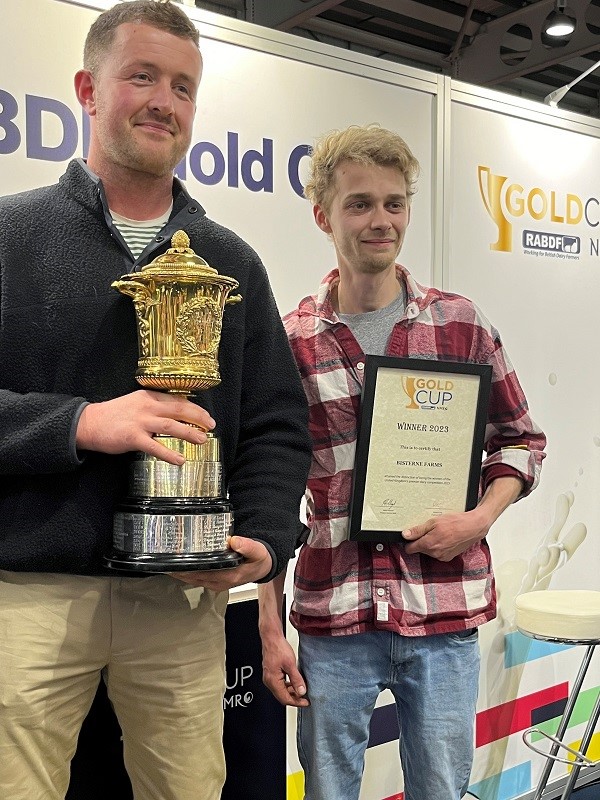Forage For Knowledge case study: George Brown
Friday, 15 March 2024
Bisterne Farm in Hampshire recently won the prestigious 2023 NMR/RABDF Gold Cup. This is a significant milestone for this dairy farm. To learn the secrets of their success and unique approach to dairy farming, I had the pleasure of chatting with George Brown whose journey with Bisterne Estate began as a joint venture in December 2019.
Today, George holds a significant stake in the farm. With a keen focus on sustainable practices and maximising resource efficiency, George’s vision for Bisterne Farm extends far beyond conventional farming concepts.
About the farm
One of the farm's defining characteristics is its diverse landscape:
- 180-ha milking platform
- 72 ha of silage leys, including red clover
- 74 ha of permanent pasture in paddocks
- 193 ha of low-input river meadows
- 20 ha of fodder beet for outwintering
- 65 ha of maize
However, with great diversity comes unique challenges, particularly in growing grass.
Herd details:
- 600 New Zealand Friesians
- Split block system
- Weigh 550 kg
- 550 kg milk solids per cow
- 6,300 L
Grass-growing challenges and the pursuit of excellence
George openly shares insights into the farm's grass-growing challenges, linking them to the region's exceptionally free-draining soil coupled with regional rainfall.
George explains:
"Our biggest challenge is the erratic nature of grass growth due to our extremely free-draining soil in a moderately high rainfall area.
"While this makes us excellent grazers during certain seasons, prolonged dry spells can significantly impact our grass yield."
Despite the erratic growth patterns dictated by these conditions, George remains resolute in his commitment to prioritise grazing, recognising it as the cornerstone of cost-effective dairy farming.
“Grazed grass is the most economical feed for our cows. That's why our strategy centres around prioritising grass above all else."
Highlighting the importance of cost ratios, George explains:
"If grass costs £1 to feed, silage costs twice that at £2, and concentrate costs twice as much again at £4. It's all about maintaining that 1:2:4 ratio."
He recalls how an inflation spike temporarily shifted their ratio to 1:3:7, emphasising the significance of grass as the primary feed source.
At Bisterne Farm, the ‘grass-first’ attitude is key in every aspect of decision-making. George stresses the value of leveraging grazed grass as the most cost-effective option for their cows.
His unwavering commitment to optimising grazing practices stems from a deep understanding of the significant role that feed expenses play in dairy farming.
Striving for milk from forage excellence
In George's eyes, the quest for maximising milk from forage begins with one simple mantra:
"To get more milk from forage, I'm going to grow more grass! It's as simple as that."
The path to achieving optimal milk-from-forage ratios isn't without its hurdles.
George admits the delicate balance between maximising grass utilisation and maintaining milk output, a challenge worsened by unpredictable weather patterns.
"We're determined to achieve both. But it's a continuous learning process. Bad grazing decisions or mismanagement quickly reflect in our yields, reinforcing the importance of sound grazing practices."
Using data for grass growth
Being part of the Forage for Knowledge (FFK) network for nine years has provided George with valuable insights and a supportive community of like-minded farmers.
"It's a chance to immerse myself in the details of good grazing management," he explains.
"The data from FFK informs our grazing decisions and plays an important role in our forage strategy."
Navigating management challenges
In George's view, effective management surpasses weather changes, placing responsibility on his shoulders.
While external factors pose occasional hurdles, proactive measures such as optimising additives and refining silage techniques remain within his view.
His firm determination to improve grazing practices underscores a commitment to continuous improvement.
Looking ahead: Magic Day and beyond
As we discuss current management priorities at Bisterne Farm, George shares insights into their preparations for Magic Day, a significant milestone in their grazing calendar.
"We're carefully managing our paddocks to ensure optimal grass utilisation leading up to Magic Day, on average it falls on the 10 April. But the unpredictable British weather keeps us on our toes."
Reflecting on our conversation, it's evident that George's dedication to forage management lies at the heart of Bisterne Farm's success.
Through careful planning, continuous learning, and a deep respect for the land, George and his team are on a path towards sustainable dairy farming excellence.
 AHDB
AHDB

